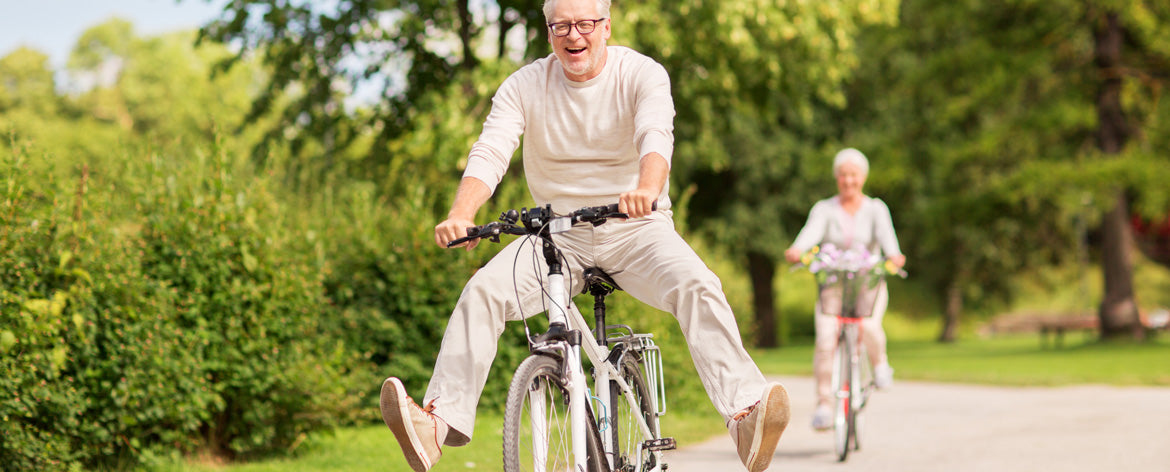What connects, moves - our joints

Walking, gripping, turning or bending: we need our joints for all these movements. There are different types of joints, such as the hinge joints in the elbow or knee, which allow us to move in one direction, the saddle joints such as in the thumb, which allow us to move in two directions, or the ball and socket joint in our shoulder, which allows us to move in three directions. The synovial fluid between the cartilages ensures that they glide smoothly over each other and are supplied with nutrients.
From joint to aching joint
If problems occur with the joints, joint wear and tear or osteoarthritis is the leading joint disease. This primarily affects the joint cartilage, i.e. the relatively thin protective coating of the joint surfaces. Damaged joint cartilage cannot regenerate on its own and joints are exposed to stress without protection. The knees are most frequently affected. Rheumatism, such as rheumatoid arthritis, is also a typical joint disease and can make itself felt in the spine, mainly in the neck and the back of the head, and can be aggravated by head movements, sometimes in the form of a stiff neck.
What is good for joints
For joints to function well, they need to be in constant use and regular and moderate exercise is good for them. This provides them with important nutrients and oxygen. A balanced diet is also important. According to the German Osteoarthritis Foundation, vitamins A, C, E and beta-carotene as well as the trace element selenium have an anti-inflammatory effect. Vitamin C is found in fruit, vitamin E and healthy fats in nuts, vegetable oils and seeds. Orange and red vegetables such as carrots, tomatoes and peppers are rich in beta-carotene. Selenium is found in pulses, nuts, herring, halibut and trout. Calcium-rich foods such as broccoli are also good for the joints. Linolenic acid, a valuable omega-3 fatty acid, can also have an anti-inflammatory effect. It is abundant in soy, rapeseed, walnut and linseed oil. Garlic, onions, ginger, spices such as coriander, nutmeg and cumin as well as fresh herbs contain valuable secondary plant substances, which also have an anti-inflammatory effect and prevent joint problems, as studies have shown. After consulting a doctor, a dietary supplement can support the supply of important nutrients to the joints.
What slows down our joints
Constant overloading causes problems for our joints. This can be caused by one-sided, heavy physical work, extreme competitive sport or being very overweight. Misalignment of limbs, such as the X-position of a leg in the knee joint, can also lead to incorrect and therefore excessive strain. Cigarettes and alcohol also have a negative effect, they promote inflammation, the joints are supplied with less blood and less oxygen. Eating meat can also trigger inflammatory episodes in the joints and aggravate joint pain, especially pork, beef and lamb. Eating eggs also exacerbates the symptoms, as do foods such as white flour, sugar and dairy products. Coffee and black tea should also only be consumed in moderation.
Exercises for the joints
If you strengthen the supporting muscles, you can do something good for your joints. The selected exercises are easy to do, even for beginners, and take little time.
Knee joint
Sit on a chair and place your legs on the floor at a right angle. Pull your toes in and stretch your legs alternately. Hold for approx. 10 seconds and slowly lower back to the floor.Hip joint
Lie on your side with one arm under your head. Straighten your knees and pull your toes in. Raise your upper leg, hold for approx. 10 seconds and slowly lower it again.Knee and hip joint
Lie on your back, bend one leg and place it on the floor. Move the other leg in the air as if you were riding a bike. Move forwards and backwards until fully flexed and extended.Shoulder girdle
Let your arms hang loosely, slowly stretch both arms above your head and lower them again. You can perform this exercise sitting or standing.Shoulder neck muscles
Stand upright, hold your right wrist behind your back with your left hand. Tilt your head to the opposite side. Pull your arm down and exhale. Repeat alternately.Thoracic and lumbar spine
- Get into a quadruped position, stretch your arms out parallel to the front and press your upper body down.- Standing on four feet, round your spine (cat hump) and then stretch and push through again.
Shoulder and neck muscles
Sit upright, tilt your head to the side, place your arm over your head and hold it in place with your hand. Slowly tilt your upper body to the side and exhale.
Joint support from the inside
To support normal muscle and bone function, we recommend taking magnesium, potassium and calcium or
vitamin C. The latter plays a role in collagen formation, which contributes to normal cartilage function. With our products Calcium & Magnesium Complex and Magnesium Compact you can contribute to the supply of essential vitamins and minerals.




